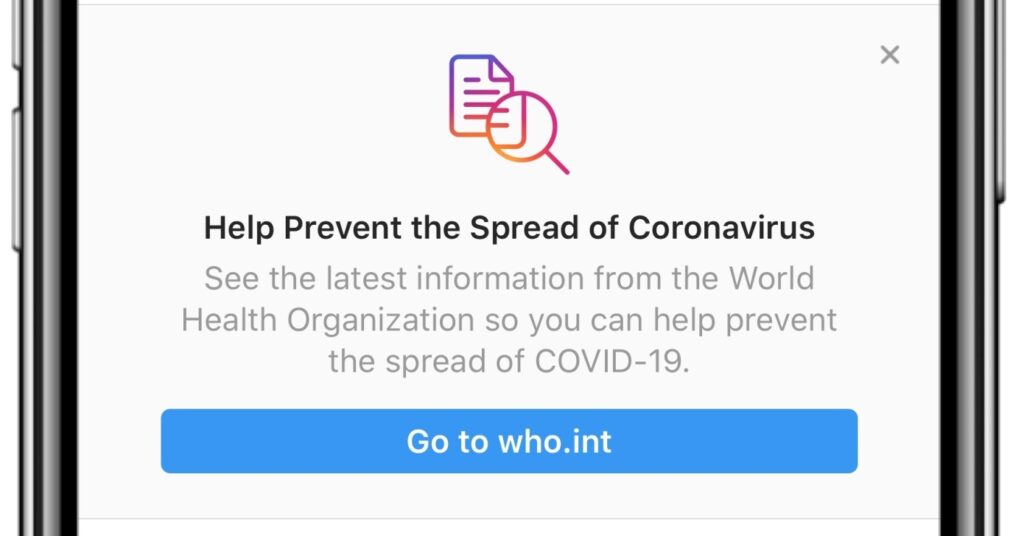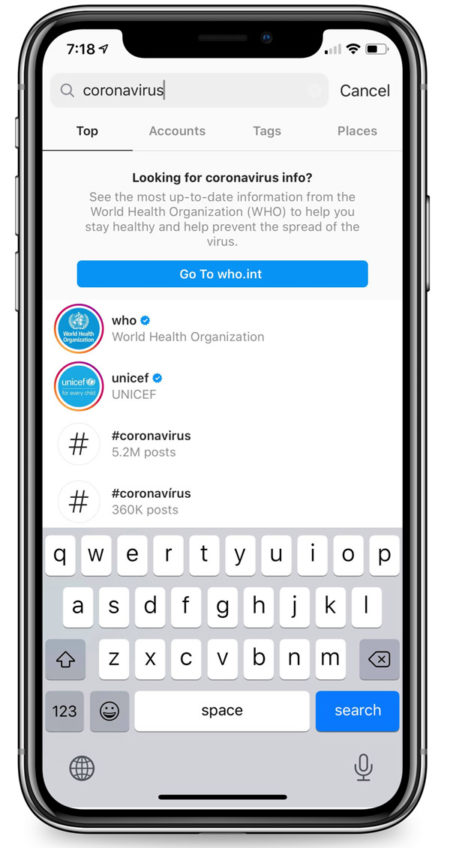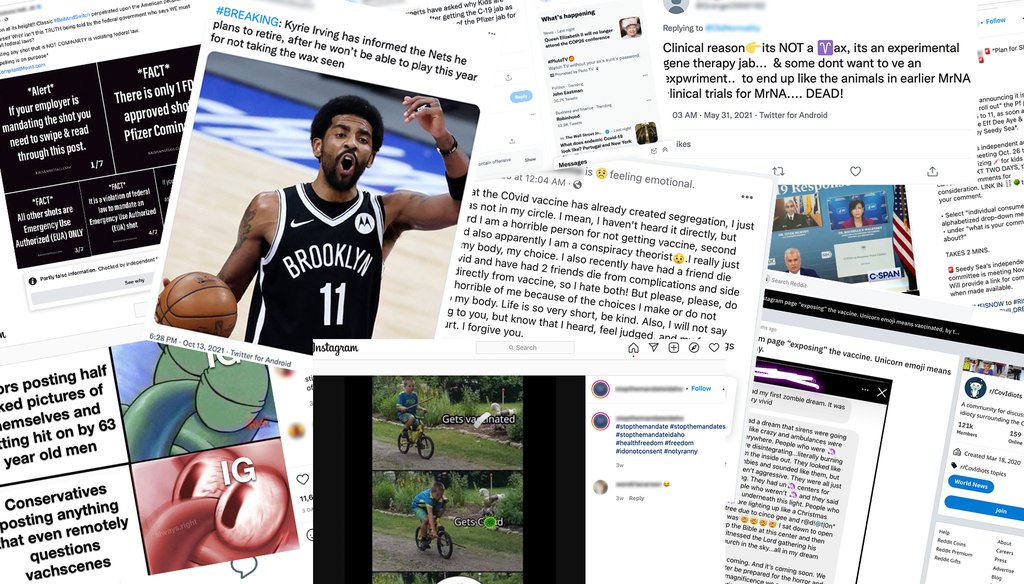Instagram Authority on Covid-19: Using Data, Algorithms and Interface Changes to Tackle Covid-19 Discourse
By Goran Kusić
Let’s unpack the title, just a little bit:
During the time of writing, we are nearing the end of 2021 and the Covid-19 pandemic is nowhere near over. The global health crisis has impacted every aspect of social life and continues to boggle governments and societies around the world. The struggles and consequences are continuously debated, restrictions vary per country and the rolling out of massive vaccination campaigns are an unprecedented phenomenon. The discussions on various social media platforms concerning the pandemic are a compelling point of analysis, because the highly contested strategies of trying to limit the impact of the virus are a moving target. In 2020, Instagram rolled out new features to help combat misinformation about the virus (Clark 2020).

On Instagram, the use of certain hashtags connected to the pandemic return results that are from sources Instagram deems credible – like the World Health Organization and the RIVM in the Netherlands – and posts that either include tags, or certain words (ie. “Vaccine”, “Covid”) get tagged with a link to a local site that provides advice and strategies (Instagram Blog 2021).

They have also added an information center where they in short form provide explanations about vaccines, their side effects and how they work (Instagram 2021). The information centers are location based, so they can provide guidelines in local contexts, as the pandemic and the strategies around it vary per country. Such interface changes and strategy rollouts have considerable consequences for how the discourse around the health crisis is shaped. The use of data, algorithms and machine learning to find, recognize and tag posts which lead to the information center needs to be considered from a critical perspective.
Scholars and theoreticians such as…
Boyd and Crawford (2012, 674) have sketched out several considerations about the use of data; one that rings particularly with Instagram’s updates features concerning Covid-19 information is their mapping of the divide between ‘Big Data Rich and the Big Data poor’. Their paper opens up critical conversations with regards to how data is used to shape conversations. They propose that Big Data and its role in doing research brings about an epistemological and ethical shift, where the process of conducting research and how reality is categorized is completely reframed(ibid).
What is interesting for this text is how Instagram uses its affordances to tag content, and the role it plays in providing quality information about a global health crisis, with the intent of stopping the spread of falsehoods – at least that is the justification for the interface changes.
There are necessary considerations when a platform that has around a billion monthly users implements strategies which accompany posts that users share. It is not immediately clear how exactly Instagram tags posts where people discuss the pandemic – the use of certain hashtags seems logical, however, posts with no hashtags where an image has keywords that could be connected to the phenomenon can get tagged and linked as well. It could be that Instagram does not want to share how they are flagging posts, as that could provide a manual for circumventing the tagging process. Yet, it leaves very little space for critical examination, when their methods and decisions are unavailable for scrutiny.
Data visualizations and journalism exploded with this pandemic, with many outlets and platforms offering infographics with local and global contextualization. While the potential of data to be used for reporting and framing global phenomena cannot be overstated, boyd and Crawford’s text still rings true in their call for questioning how data is used, by whom, and to what ends. According to Petrina (2021, 224) data has even become a subject, which reshapes our understanding of what a subject is. Usually, it would be understood as a coherent entity, while in the case of data which is fragmented and needs to be put into context to be unified, the philosophical conundrum of data as a subject presents a radical reimagination of its role and identity(ibid). Petrina’s proposal functions as an extension of boyd and Crawford’s call for critical examination; one must consider the role, status and access to data that Instagram has, and how they subsequently employ their strategies, and further, how we can see data as a subject in the provided discourses on the pandemic.
When companies as Instagram roll out new features in their algorithmic and datafied interfaces, the question of who gets insight is omnipresent within media studies. The black-box nature of tech behemoths is nothing new in the conversations on the use of data, algorithms, privacy and machine learning; however, in this specific crisis there needs to be space for critique of access and accountability. If Instagram’s changes to their interface and the tagging of content is indeed so crucial for people to have access to certified information by health authorities, who is in position to examine the platform’s role, their ethical considerations and the teams behind the processes.

In order to roll out such major changes and have an almost infinite stream of content be affected, decisions have to have been made about how this will be implemented. According to Gillespie (2014, 167) algorithms do not only help us find and filter information, but act as a means of participation in socio-political discourse, because they are a crucial component in the flow of information upon which people then assign meanings, importance and truthfulness.
CONSIDER THIS…
From a scholarly perspective it is compelling to question why and how these decisions were made by the platform, are there possible alternatives and who holds Instagram accountable. Upon initial examination it might seem harmless to tag content with the intent of providing scientifically corroborated information in a health crisis. Yet, Instagram is not an official authority on information and takes considerable decisions that can have massive impact with little transparency in their methodology. Again, it is in no way peculiar that a technology company makes decisions that have major implications without much input from the user base, or with very little communicated clarity. Another interesting development is the creativity with which people avoid their content being tagged. For instance, by changing letters in the text or using specific keywords.

It is far beyond the scope of this commentary to consider all the implications of such tactics; however, it points to several compelling phenomena that tie to the use of digital platforms. One of them could be the creation of counterpublics – Milner’s (2016) concept where he proposes that such public challenge dominant discourses. Or perhaps the political nature of content creation that is meant to avoid tagging. At the core of the proposed considerations are the use of data and platform interfaces to shape narratives and discourse during a global pandemic. When a platform is as massive as Instagram is, the role it plays in contributing to such a discourse needs to be acknowledged and scrutinized. Critically examining its use of data, algorithms and interface choices that shape narratives, decide who has access and authority and in turn function as a catalyst for users to employ tactics and mobilize to try and ‘trick’ the system.
BIBLIOGRAPHY
boyd, danah, and Kate Crawford. “CRITICAL QUESTIONS FOR BIG DATA: Provocations for a Cultural, Technological, and Scholarly Phenomenon.” Information, communication & society 15, no. 5 (2012): 662–679.
Clark, Mitchell. 2020. ‘Instagram Is Rolling out New Notifications about COVID-19 Information’. The Verge. 17 December 2020. https://www.theverge.com/2020/12/17/22187298/instagram-coronavirus-covid19-misinformation-notifications.
‘COVID-19 Information Center’. n.d. Accessed 30 November 2021. https://www.instagram.com/coronavirus_info.
Gillespie, Tarleton. “The Relevance of Algorithms”. In:Media Technologies: Essays on Communication, Materiality, and Society, edited by Tarleton Gillespie, P J Boczkowski, and K A Foot, 167-194. Cambridge MA: MIT Press, 2014.
‘Helping to Inform People about COVID-19 Vaccines | Instagram Blog’. n.d. Accessed 30 Novemberr 2021. https://about.instagram.com/blog/announcements/continuing-to-keep-people-safe-and-informed-about-covid-19.
Petrina, Denis. “Affect Trapped: Algorithms, Control, Biopolitical Security”. In: Living and Thinking in the Postdigital World, edited by Wróbel, S. Skonieczny, 219-231. Krakow, University of Warsaw, 2021.